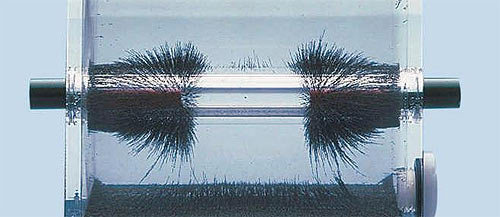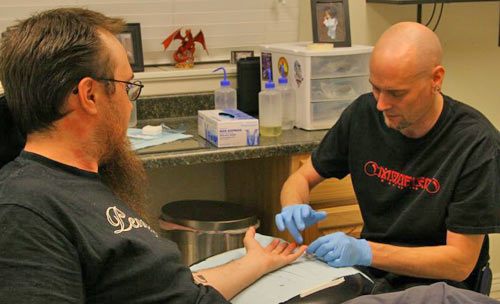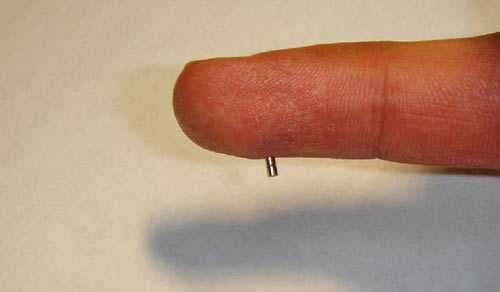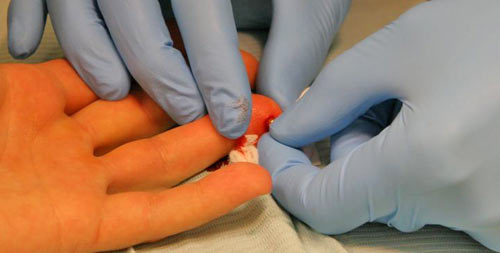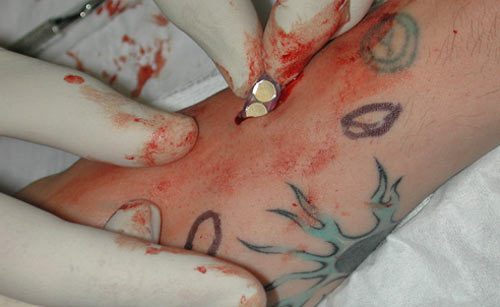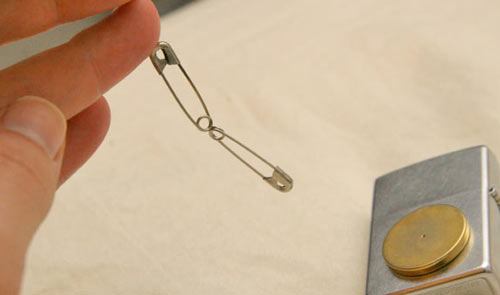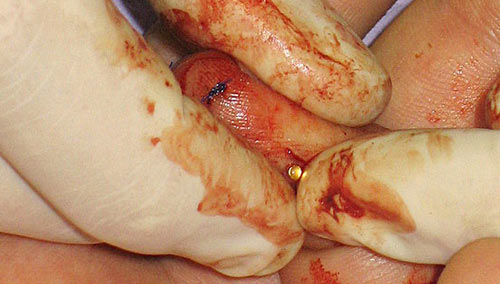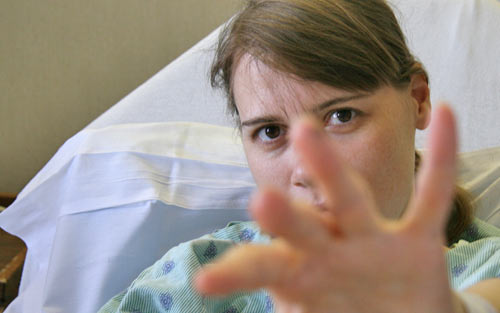
If you don’t already know about magnetic implants, you may want to read our previous articles on the subject, including the original interview about Todd Huffman’s magnets, a six-month retrospective on mine, as well as a magnet risks article with a follow-up by Jesse. In short, magnetic implants are small, encased magnets designed to be implanted in nerve rich areas in order to give the patient heightened sensitivity to EM fields — that is, magnetic vision. Because the magnets vibrate very slightly, the wearer’s senses begin to extend, giving them an awareness of electromagnetic fields and radiation.
In this interview I wanted to talk about the “day-to-day” aspect of having implanted magnets — “what’s it like?” Magnetic implants are still quite uncommon, with possibly less than a hundred people having them. We’ll talk to eleven here — in order of when the magnet was implanted, Todd Huffman ([email protected]) had his done in January 2004, a stack of six magnets in a single case, implanted by Steve Haworth and made by Jesse Jarrell (Mr. Bones), who had a silicone case molded 1/16 length X 1/8 dia N45 NIB installed by Steve a few days later. Steve Truitt‘s magnet was self implanted in mid-2005 (and removed about a year later), and my (Shannon’s) magnets were done at about the same time by Steve Haworth. Also by Steve, Quinn Norton‘s magnet, since removed, was implanted in September of 2005. Jymmi‘s magnet was done in September 2006, and Powder‘s was done a month later, both by Steve Haworth. Fred has a 1/16″x1/16″ neodymiuym magnet implant in a custom made titanium casing (all the others here are in silicone), implanted by Nickk Leading. Anton and Dean were both done in January of 2007, and KYO got his most recently, in April 2007.
When and how did you become aware of being able to sense things with your magnetic implant? Fred: For the first month I thought this was a failure; my main goal was to be able to sense things and I hadn’t sensed anything so far. I work for a company where we manufacture a number of electronic things, and one day my friend was testing a large 230volt power supply with a huge transformer in it so I walked up and waved my hand in front of it and got that cool vibrating sensation in my finger tip. Immediately after I just started putting my finger up to several things I knew had transformers, clocks, cell phone chargers, and microwaves. So far my nebulizer, which I use for my asthma seems to have the strongest field. Steve It was probably two weeks into having it that I started sensing things. I could feel my microwave stronger than anything. Jymmi: I could feel small things at about a week to two weeks, like an electric shaver and a one inch earth magnet. After about three or four months I also could feel the electric fields in my non-magnetic hand. It’s not as strong as my magnetic hand — it’s more of a general feeling. About a month ago I started feeling the vibrations in my feet. Powder: A few days after I had the implant done I was standing in my father’s garage near a large running engine. I felt what I thought was a light breeze on my hand but realised it was only in my implant finger. I started moving my hand closer and farther from the engine and felt slight differences in the sensation. KYO: On the sixth day I picked up an electric sharpener and had a weird sensation — then I realised it was actually the magnetic implant reacting to the electro magnetic field from the engine. Jesse: I tried static fields from large magnets fairly immediately after insertion, but the first really astounding sensation was provided by a power drill. Todd: To quote from my blog, two days after getting the implant:
Dean: The first thing I noticed was while drinking a can of Coke. The magnets themselves obviously weren’t strong enough to pick the can up, but I could feel a slight sensation when holding the can itself. The best way to describe it is a tingling sensation. To date, I am the only person out of the three i know with the implants to get this with a can. Quinn: Right after the implant, Steve passed a magnet close to my finger. I felt it move, and jumped. After that I wasn’t sure which sensations were the healing process and which were the magnet, but as time went on, I was able to distinguish more. Shannon: The first thing I noticed was the drives and fans in my computer. I think I remember a vague buzzing in my fingertips, wondering what it was, and then moving my hands around and realizing that I was sensing definite fields and from that point on it snowballed (although I think they may be becoming less senstive over time — I don’t know if this is due to scarring or demagnetization).
What range of sensation are your magnets capable of? Anton: I can feel rather faint magnetic fields and also electric currents at times, depending on how strong they are. Fred: I can’t feel store security poles, but I have felt a metal detector as I walked through — surprisingly it didn’t go off like I thought it would. I have to have my hand less than a foot away from whatever I’m attempting to feel. Jymmi: I am more sensitive to electrical currents. Sometimes the implant will vibrate or twitch depending on what I walk by. We have these big space heaters at my work, about fifteen to twenty feet up in the air and my whole hand vibrates when those turn on. We also have electric forklifts, and when I get close to the battery chargers it feels like an electric current running up my arm. Steve: I could sense some electrical currents on certain things, especially larger things like my stove or dryer. I could feel certain types of security sensors at some stores. I was never able to feel anything from my computer though. Powder: I can feel different amperages in various cables. I can also tell when a metal is a ferous or not. My favorites are the fields around microwaves (a couple of feet out), AC transformers (a few inches), and fans under the keyboards of laptops (about half an inch above and while typing). KYO: range is hard to define since I find new things on a daily basis. But I’m basicly able to feel the magnetic field around magnets, my computer, some speakers, the oven, some fields around the electric wires (I can actually detect the flaws since the lower protection allows the field to get trough). Jesse: On the lower end I can feel higher power draws through standard 120v insulated power cords (wall power), various functions inside computer equipment(from a distance), magnetism in the more magnetic alloys, on to stronger things like various components of high voltage equipment used in my machine shop, including insulated high voltage leads from a foot or more away, transformers, motors and magnetrons wherever they may exist, store security devices, the stove, and so on.
Todd: Static fields are pretty uninteresting, and need to be pretty large. Oscillating fields I can sense at much lower amplitudes, and are more interesting because they occur more frequently in the real world for things I find interesting. I’ve never quantified the exact range, but I can sense a current running through an insulated wire if there is enough of it. Whatever a power cable to a hair dryer pulls I can sense, and probably about three quarters of that current. Dean: The magnets themselves aren’t that strong, although I am able to pick up tiny pieces of metal and can also use them for various magic tricks in conjuction with my magnetic wedding band ring. The most sensation I get though is when walking through magnetic fields — those sensors they have by shop doors. Again it’s like a tingle within my finger, almost like a sixth sense. Quinn: I felt about three different sensations from my implant. I can’t really describe them very well, but one of them I got consistently from my laptop, and another from electrical cords. The third I felt very rarely… And of course, a fourth: other magnets pulling on my finger. To this day one of the oddest things I have ever felt was the magnet spinning in my finger in response to circling it with another magnet. I tried to practice with it everyday, bring it close to things I thought would be sensable and concentrate on the sensation. After a while it became a comforting and even enjoyable thing. I would pass the magnet over parts of my laptop, and feel them consistently. After a while it helped me feel kind of like all was well with the world. I enjoyed concentrating on the feeling more than I thought I would. I was pleasantly surprised when I would run into unexpected sensations. Shannon: I can barey feel static magnetic fields unless the field is very powerful (such as a large magnet). Vibrating EM fields ranging from spinning magnets in engines (power tools, the fans and drives in a computer, and so on) to any A/C or otherwise fluctuating electrical fields are very easy to feel. Powerful fields like you find in some security systems (especially the type that need to deactivate tracking tags) can actually be quite painful, but essentially an EM fluctuation is just like a physical vibration. So for example, a power cord will have a “buzzing” halo around it that I can feel without touching the cable itself. The size and tone of this field make it fairly obvious what I’m touching.
What are some day to day ways you use your magnets? Anton: I work in a hospital (in the ER) and I can tell if the MRI is in use about fifty feet away from the room. Needless to say, I can’t go in there when it’s on, or it will rip the magnets clean out of my finger — I guess that’s one way to remove them. Fred: I actually use my magnet quite a lot, mostly just to see if stuff is turned on. I am able to locate transformers inside objects and thus detect if they are on. I work in production where I make tons of different electronic components. It’s fun because Im around a lot of huge transformers so it’s interesting to see how strong each of them are. I found a magnet under my bed once by feel alone, even though I wasn’t even looking for that and couldn’t see it. Jymmi: I like to walk around work or through a store or just from room to room in my house and find different places that give off electric feilds — like air conditioners, tattoo machines, and refrigerators. I use my laptop everyday and there are still a lot of fields that I can’t figure out where they are coming from — the disc drive is kind of going bad and everytime it spins trying to read discs it puts off a crazy field. There is a small field around the steering wheel on my car — I can’t figure out if it’s from the metal vibrating. or if there is a magnet somewhere in there. Some cars have it, some don’t. Steve: I didn’t really have any day to day uses other than just being able to sense things. Now that it’s been out for over a year, I can still sense the same magnetic feilds, just not as strongly. Powder: I have used it to find hot cables in a bundle, and sometimes use it to test reed switches in some of the electronics I repair.
KYO: Working at McD, there are the fries that beep once the cooking is completed, and the magnet allow me to know about a second ahead that they will beep since there is a diffrent field that appears to make the alarm go on. Also, my imitation iPod tends to turn off by itself or simply go on pause, and the magnet allows me to know if it’s on or not without taking it out of my pocket. My cellphone is on vibrate, and I’m never sure if it’s my cell or not, but by holding my finger about half an inch away, I can tell for sure if it’s actually the cell that’s ringing. Finally I had used my magnet to troubleshoot a laptop, being able to detect something strange under the keyboard, and the tech did change a card that was located exacly in the area I had spotted the irregularities. Jesse: Immediate awareness of high voltage is very comforting in a lot of ways — there is a reasonable amount of it around me in the shop where I live. Determination of ferrous alloys is frequently handy without having to go look for a magnet. Circuit tracing inside various equipment is often aided by it. Common shop dialogue: unenhanced individual: “Hey, what the hell is thing I pulled off that old assembly line?” enhanced individual: “I don’t know, but its got magnets inside the case here, here and here, I’m guessing the two along that guide rod are for positional sensing, and the one over here is probably a transformer.” An interesting note is that I sometimes get “noise” from it — moving fields with no apparent source. Some of it may be the magnet just “righting” itself after being moved by a previous field or physical force and slowly settling back into a position that fits better with the tissues in my finger, but there have been a few occasions that were not so easily explained away, where I sensed apparent moving fields in open air with no visible source. Todd: Occassionally I use it for diagnostics. For instance, in airports often the power plugs on the walls don’t have power, and I can test them out by just plugging in my power adaptor and feeling for the field — I don’t have to get my computer out. One time I was trouble shooting a water pump, and I could tell that the motor component was working just by feeling the fields, letting me know that the problem was with the pump-shoe thingy. I can also feel my laptop’s hard drive stepper motors, and I like knowing when my computer is moving out of RAM and dropping down into the HD for info. Dean: I usally get most of my day to day use out of the magnet when going in and out of stores. It also helps to tell when certain things are turned on if there no other signs to tell you so. Like my computer monitor… the standby light has broke, but I am able to tell if it’s on standby of not by placing my hand on the screen. Then again though, it really is an old messed up screen. I really should replace it. Quinn: A couple times, in determining if something was live or not. Once, I was able to work out that a demo wasn’t realistic based on the sensation from a cord. Shannon: I’m very aware of power, so for example it’s easy to tell if something is plugged in because I can feel the power leaking out of the extension cord (and I can tell how much power is being drawn — and also tell the quality of the cable assuming there’s a frame of refernece). In day-to-day life, my electric stove has bad connections in some of the burners, so the amount of heat that a given dial-setting generates is different from day to day. Now, instead of using the dial, I just hold my hand an inch or two over the burner and “feel” for the right setting by sensing the amount of power that’s leaking off the coil. It’s actually quite fascinating how EM-saturated our environment is.
Does your magnet have functional (as in non-sensation) uses? Fred: Sadly, I am only able to pick up other magnets and only small things like staples. Anonymous: I’ve gotten laid a number of times directly attributable to the implant. Occasionally a girl on the fringe of my social group will be all like “are you the guy who put a magnet in his finger?” (swoon). Anton: I can pick up very small, very light objects, and move the compass on my keychain — it’s great for bar tricks. Jymmi: The most I can do is pick up screws, paper clips, and bottle caps — or spinning lighters. It really freaks people out when they hold your finger and you move the implant around with another magnet they can feel it moving around under the skin. Steve: It didn’t hvae any functional uses for me, other than some “party trick” type stuff like picking up paper clips or things like that. Powder: I use my magnet to pick up small screws I might drop while working on various electronics. I have used it to single out a cable in a bundle of cables. I mostly use it to do small magic tricks like playing with my compass or rolling other magents around without touching them. When I’m bored I’ll play by swinging a paperclip back and forth. Todd: It has functional use in that it helps me reconceptualize the world around me, and every now and then I say something smart, and that is what people pay me to do. I got into my PhD program solely because of the implant. I was at a conference and some dude was all like, ‘there’s this dude who put a magnet in his finger’ and I was like ‘oh thats me’ and he was like ‘no, really’, and I was like ‘no really’. Then he made arrangements for me to get into my PhD program. Which I promptly dropped out of for sociopolitical reasons but it was pretty cool at the time. Dean Newman I suppose the most use i get out of the magnets again would be when using with magic. Stopping a compass, or sometimes even a watch although that is a lot harder. After a while i was able to use it to “palm” certain objects although nothing bigger than a paperclip.
Why do you think some people report magnetic sensations without the magnet? (Both in new areas, and after removal) Jymmi: I’ve been wondering if you need to have the implant to feel the electric field — if you can train your body to feel it without the implant. It would probably explain why I can feel it in both hands and feet, or maybe i’m just a freak. I think it is real. I’m not sure if it’s nerve density or something biological like high iron in the blood? Todd: I sometimes percieve the magnetic sensation in two fingers, my left ring and pinkie fingers. However, I only have the impant in my left ring finger. I’ve thought about this phenomenon, and here is what I have believe is occuring. In the course of normal finger operation your pinkie and ring fingers often percieve things in parallel. For instance when you grab an ass or run your hands down a woman’s back those two fingers are feeling pretty much the same thing. Your nervous system has limited resources for transmitting information, and uses clever tricks to up the amount of information processing per calorie. Since those two fingers often run in parrallel, at some point for efficiency the nervous system constructed a compression algorithm. The dual finger perception with only one implant is an artifact of that compression. The phenomenon isn’t 100% consistent, I’d estimate 10% of the sensations come up dual. Shannon: I can’t currently sense EM fields in any place other than the fingertip that contains the magnet stack (and the ones that have been removed don’t appear to retain any sesnation), and don’t have any “crossover” between fingers. Quinn: I suspect this is a matter of learning to concentrate. Before I went to Phoenix I designed a test just to make sure it was real, picking out a live wire from 4 choices. We did it double blind back in California with unmodified controls. People actually could pick out the live cord better than the stats would have had it. When I sat down to try it, I could pick out a live cord about 80% of the time, about twice the other controls. We were all surprised, but after talking to some people that worked with electronics, it turned out this was not at all unique. I think it’s entirely reasonable to think that learning to concentrate on AC would let you do it with your skin even without a magnet; though not as reliably. We are, after all, conductive. Please note that magnetic implants are still highly experimental and the underlying encasement technologies and so on are not yet mature. If you want one, please be sure to research and understand the risks in advance!
|
Search Results for: 20040226.html
Always consider the risks
…and more importantly, how you’ll handle them. Because if you don’t think you have the resources to deal with potential problems, you should strongly consider whether those risks are worth it.
Although the experience of having magnetic implants is remarkable — you can literally reach out and “feel” power running through cables, engines spinning inside harddrives, power leaks in the surface of electric stoves, and much more, all without physical contact — the experience of having to remove the implants is all too common and extremely unpleasant.
The majority of silicone dipped mangetic implants (which as far as I know are no longer being made) installed so far have ruptured and broken down (which happens within a week of the shell opening), and removal requires a large flap and the excision of some tissue because of how dramatically the magnetic disintegrates — as you can see it’s essentially a powder.
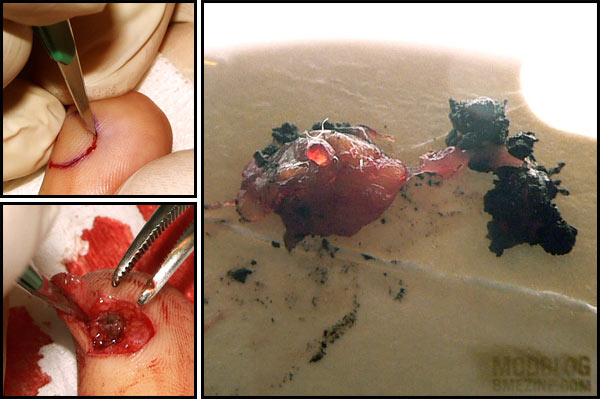
This magnet was installed by Steve Haworth (to be very clear I understood the risks and removal procedure and have no hard feelings toward anyone about how it turned out) and removed from my finger by Tom Brazda. For me the experience, while rather unpleasant at the end, has definitely been worth it.
See also: Initial BME article on magnetic implants, my magnetic implants (getting them), and the removal of my first magnets.
Magnetic Implants: A Six Month Retrospective [The Publisher’s Ring
 A Six Month Retrospective |
Life is “trying things to see if they work.”– Ray Bradbury
In early 2004 BME documented the concept of magnetic implants for the primary purpose of sensory augmentation. You can read that article for an introduction and information on the originators, but the basic concept is that if you implant small magnets under the skin, they will move in response to an electromagnetic field and transfer this as sensation to the surrounding nerves. This in effect allows one to extend “vision” (or touch) into the electromagnetic spectrum, giving you a sixth sense that normal humans do not have — the first real “superhero” modification?Roughly speaking, magnetic implants break down into the following types:
- Sensory
I believe this is the most important type of magnetic implant (as I’ve described above), and it is what this article focuses on. - Sexual
Magnetic implants placed inside the sensitive genital anatomy of a couple (so each partner has their own implants) have the potential of interacting, enhancing the feeling of body parts moving against each other to include anatomically internal sensation as well as normal external stimulation. It is difficult to say how perceptible these would be though, if at all. Paired implants in lips (also highly sensitive) are a related variation. - SymbolicAnother variation on couples implants is more symbolic than functional or erotic is paired hand implants, placed in order to create a magnetic bond as the two people hold hands. I do not believe that the static magnetic field generated by small implants is enough to be felt except as a placebo, so this would generally be something I’d consider purely symbolic in nature.

Couples implants on Steve Haworth and his partner Cookie - Functional
Most of the magnets used above are too small to actually pick up anything larger than a small paperclip or staple. Larger magnetic implants are in theory able to pick up screws and heavier items, potentially making them quite utilitarian in nature. This is however complicated by the fact that placing a large enough magnet under a fingerpad is not entirely comfortable.
In relation to the last type, sometimes people ask about whether magnetic implants could be used to hold a watch or eyeglasses or other appliance in place. The short answer is that this is not safe or viable. Even very slight compression (as you’d have between the internal magnet and the external device) can quite quickly cause the tissue to be choked off, die, and induce rejection. As a point of trivia, this is why it can be so dangerous for a child to swallow magnets — if two magnets clamp across the intestinal wall, they crush it and it leads to the development of a very dangerous hole.
That said, the magnets involved are also very small, so attaching devices wouldn’t be easy because they’re just not powerful enough. The good thing about this though is that the magnets have zero effect on credit cards, hard drives, monitors, and so on.
Personally I sought out magnetic implants for sensation — to experience more of the world around me and have a deeper understanding of physical existence — which brings me to Steve Haworth and Jessse Jarrell.

The location of my five (ten?) magnetic pellet implants
Getting them done
The first generation of magnetic implants have been manufactured by Jesse Jarrell (IAM:Mr. Bones, who you also know from projects like Kaos Softwear) and have been primarily installed by Steve Haworth (IAM:steve haworth), easily the most experienced implant artist in the world and one of the only ones that I trust to work on me. After making plans at the 2005 APP meeting in Las Vegas to do the procedure, it was just a matter of being able to synchronize our busy schedules. This ended up happening a month or two later as I was on a road trip from Chicago with my wife Rachel (IAM:MiL0) to our home at the bottom of the Baja Peninsula in Mexico.
After discussing various placement options and configurations, we decided to try two different possibilities so I could help assess which worked best — a “grid” of four single magnets, and a set of five or six magnets stacked up and encased as a single unit. The magnets themselves are rare earth neodymium magnets (so they are quite strong for their size) and are encased in silicone to make them safe to implant (safer anyway). One of the magnets I’d had for some time, and the others were made to order that day by Jesse. The process of autoclaving can weaken the magnets, so they were disinfected using a chemical soak.
While one could in theory implant the magnets using a needle follow-through method similar to a beading, we put them in place by first making a small incision in the tip of the finger and opening a pocket using one of Steve’s smaller dermal elevators. It took a remarkable amount of force to create the pockets. After each pocket was ready to accept the magnetic pellet, Steve (assisted by his partner Cookie; IAM:Miss Cookie) used the back of a taper to push them into the hole — this was quite difficult to do as the magnets themselves are about a third the size of a grain of rice, very smooth and slippery, and of course the hole had blood in it. But, after a little fumbling with them, they each were in place. Small sutures held the wounds closed and I was bandaged up. The five separate incisions and placements were all completed within half an hour, and while having the ends of your fingers messed with is certainly highly unpleasant, it was far easier than I’d anticipated.


Inserting several of the small magnets — you can see how tiny they are!
Closing the wounds with single sutures.
ABOVE PHOTOS BY RACHEL LARRATT
They were quite tender for the first week until I cut the sutures out, at which point the pain went away almost immediately. If I touch the area they can be felt and are a little tender if pressure is applied, but not so much that they affect typing or most things I use my hands for. The incision points have left several tiny, almost invisible scars — nothing you’d notice unless you know what to look for. The implants themselves are not visible and do not distort the skin because they’re so tiny. As of this writing I have had the implants for six months.
Effects and Sensation
Jesse had told me that it could be a month before I’d be able to feel anything from the implants due to the surrounding tissue taking time to normalize, so I was surprised when I felt a strange sensation in my fingertips as I used my computer about a week after the procedure. My laptop at the time had dual harddrives and due to using a desktop CPU, an inordinate quantity of fans. Running my fingers through the air over the surface of the computer I could feel a faint vibration coming from each of these microengines, and this vibration changed slightly as the actions of the engines changed the electromagnetic field they were generating. It’s hard to exactly describe what it feels like — it’s definitely not as simple as “I can feel the implant vibrating under my skin”, which is true, but I am completely unaware of the presence of the magnets… It’s more like being able to “touch” the EM field. It’s very tangible, and the best way I can describe it is a combination of vibrating air and a strong sense of static electricity.
Later on I started being able to sense other fields as well. Sometimes I can feel store security gates as I pass through them, although usually I can’t feel them at all unless my hand happens to pass very close. Only once (at an art gallery in Paris) did I experience a very obvious gate — it was turned up so high that it was almost painful at a distance of two or three feet, feeling very much like dipping my fingers into an ultrasonic cleaner; an extremely fast and aggressive vibration! My theory is that the system was malfunctioning, but of course no one else could possibly have been aware of that. Another device that generates a very strong field that I can feel from a distance is my microwave. What’s particularly interesting about that is if I put it on a variable program (ie. defrost and reheat a plate), I can feel the EM field’s vibration strength and frequency change as it passes through different stages in the cooking. I’m not sure if I should worry now that my Mexican-bought microwave is not properly shielded? Finally, I can also feel the vibration of power transformers and sometimes even emissions from power cables themselves. Our environment is sensually rich in ways most people are completely unaware of!
So far with the limited number of people who’ve gotten these implants it seems like different people are more sensitive to different types of fields — personally I am most sensitive to motors. I don’t know if that’s due to subtleties of the placement and orientation of the implant, or if it’s something related to the person themselves. As I mentioned above, I have different magnetic configurations in each hand; four individual magnets in a grid in my left hand and a long single stack of magnets in my right hand. Surprisingly, my experience has been that there is absolutely no difference between the two. To me they feel completely alike. This also makes me believe that the differences that various people have experienced in what they can sense is due to their own innate nervous structure rather than the placement itself.
Problems
The biocompatibility of neodymium has not been investigated (so carcinogenic and mutagenic toxicity and so on are complete unknowns) but it is considered a generally toxic irritant and moderately poisonous with documented adverse effects. Really, no reasonable person should be asking for exposure to it by implanting it under their skin! Let me emphasize that this is a fundamentally risky act with unknown consequences.
In order to keep the neodymium from coming in contact with the skin, the magnets have to be coated with something inert. In my case and in the case of all the others that I know of, this is achieved by coating them in a sheath of biocompatible silicone (the same type of medical silicone that is used for everything from chin implants by plastic surgeons to 3D-art by non-medical practitioners). Unfortunately so far this solution has not been entirely ideal.
In my own case, I found myself with a hankering for pickles one afternoon and needed to open a jar of them on which the lid had become stuck. I grasped the jar with my right hand and the lid tightly with my left and turned. As I did so I felt a pain around one of the small magnets in my left hand as shearing forces tore across the magnet and its sheath… I realized immediately that I’d just “peeled” the silicone off of the magnet. There was a slight inflammation and soreness over the next week but it settled down fairly quickly. However, as time has gone by the surrounding tissue has blackened, confirming my theory that the neodymium was exposed to flesh. I haven’t decided yet what to do about this problem. A reasonable person would probably choose to remove at least the compromised implant, but I’m not a reasonable person. So for now it has become another experiment. I worry as well that my stacked magnet is going to break in half if I hit it wrong.

You can see the discoloration from the compromised magnet.
In addition to damage to the silicone sheath from shearing forces and impact damage, the current method of production — hand dipping in liquid silicone — is problematic because it can very easily result in thin patches that are sensitive to the point where they become compromised during the process of insertion. If a mold is eventually made for casting the silicone sheath this problem should be all but eliminated.
Unfortunately I am not the only person to have experienced complications. My friend Monte Vogel (who you know from BME’s QOD and as IAM:MONTE) had to remove an implant from a client’s lip. I should note that while he removed it, the implant was put in place by an inexperienced practitioner in Minnesota using a traditional beading style procedure (ie. piercing with a 12ga needle and following this with the magnet). Somehow during the procedure it seems the silicone sheath (already extremely thin in spots due to hand dipping) was compromised, exposing the neodymium to flesh, and this was compounded by problems with migration.
BME: What necessitated removing the implant?
MONTE: It had moved into the upper tissue layers and looked like a growth or cyst just under the tissue, and became both a visual and physical nuisance.
BME: What was the removal procedure like?
MONTE: I used a #11 scalpel to gradually cut my way into the area, blotting it with gauze as I worked. Extra precaution was taken going in so that I wouldn’t damage the implant since we didn’t know at the time that it had been compromised. When I got to the area all I saw were little black flecks. I gently tweezed out the ones that I couldn’t pick away with the scalpel blade tip. Below these pieces was the majority of the implant.
I never saw the implant before it was placed, so I don’t know what it looked like originally. What I removed was the small magnetic piece with half of the silicone casing still attached to the back side with no other silicone pieces to be found. The silicone was translucent making it impossible to see. Imagine dropping a contact the size of half a pin head — the original intact pellet implant was small enough to be placed with a 12ga needle.
BME: What was the condition of the surrounding tissue?
MONTE: The surrounding tissues that had been in contact with the exposed side of the implant had stained a darker color. This made it even harder to find and remove all the little flecked pieces but I spent extra time to make sure that I removed everything I could see and find.
BME: Given what you’ve seen, what’s your assessment as to the viability of this procedure and type of implant?
MONTE: The implant’s thin silicone coating is very fragile, and with all of these potential points of compromise it is hard to say how safe any procedure of this type would be. This is definitely not something you would want to have an inexperienced practitioner do. Know the risks and reduce them as much as possible.
My own assessment as to the viability of these implants is that figuring out a strong and durable sheath is essential. I would strongly recommend that perhaps even an alternate polymer, or at least a much harder silicone, is required to safely implant neodymium or another potentially toxic substance into the body.
Conclusions
First of all, let me say that I’ve been very happy with my magnetic implants so far, and that I understood the risks (and accepted the unknowns) coming into this. The experience of developing another sense (or at least a pseudo-sense that extends my ability to “touch” in new directions) has been very exciting and illuminating, and I wouldn’t want to give that up. For me the effects have been more of a curiosity and growing experience than something objectively “useful”, but Jesse Jarrell who has a more electrically-oriented life tells me that he’s been finding them genuinely functional:
“I find I use mine more and more as a true tool or utility, especially since I have moved into a new warehouse and have been doing a lot with wiring and construction, where the sense actually comes in handy surprisingly often. I think professional electricians would get a lot from these.”
That said, it is not a procedure that I can recommend in good conscience until the containment problems (the delicacy and potentially short lifespan of the polymer sheath) are solved. I believe that knowing what we know now that implanting the current style of magnetic implant is irresponsible and reckless. However, once this problem is solved, I recommend these implants whole-heartedly. In terms of the configuration that I recommend, I believe that groups of single, small magnets are far safer than and just as effective as the stacked groups.
Jesse concurs and gives us a hint as to his future developments,
“My thoughts for improvement have gone towards more and smaller magnets. We may be getting our own parylene coater soon [ed: parylene is a biocompatible dielectric coating that is commonly used to shield non-compatible medical implants from surrounding tissue], so that would allow for a much thinner but still robust coating.”
“I like the idea of a dispersed magnetic dust — lots of tiny units spread across an area. It wouldn’t be the easiest to install or remove, but I think it would yield the best sensory results. I also think longer thin strips of tiny magnets might be a nice compromise for installation and removal ease.”
I definitely like the idea of an implantable magnetic dust that could sensitize large areas of skin and look forward to seeing where functional body modification goes in general. For me, I probably have to steel myself for some serious discomfort and take scalpel to fingertip and remove the problematic implants. I wonder how blind I will feel having been given this extra vision and then losing it again?
If you’re interested in having magnetic implants done yourself, or are a practitioner looking to buy them, my advice would be that you contact Steve or Jesse directly. Links to their IAM pages are above, and you can also visit stevehaworth.com and jessejarrell.com directly for alternate methods. Good luck everyone, and if you try something, please be sure to let BME readers know how it went for you!
Awww, isn’t that sweet!
As you probably know I have magnets inside my fingers, implanted courtesy of Steve Haworth (made by Jesse Jarrell and previously covered on BME). My magnets are mostly intended to be functional, to give me “magnetic vision“, but Steve and his partner Cookie recently opted for something far more romantic.
Each one got two magnet implants done; one in the fingertip, and the other behind the knuckle, positioned so that if they are holding hands, the magnets draw toward each other, linking them. It’s yet to be determined whether there will be a noticeable sensation or not (the magnets are very small), but on a purely symbolic level I really love it!
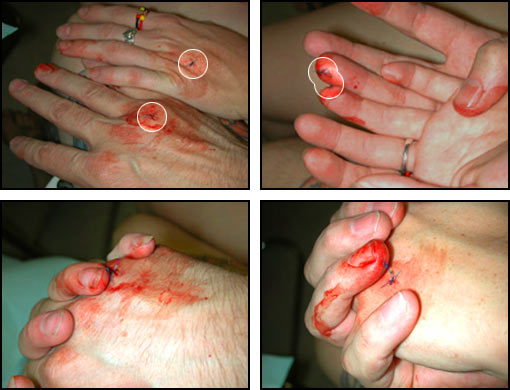
If you’re interested in something like this (or are an implant artist looking for silicone coated magnets), you can contact Steve via his website at stevehaworth.com.
The Lizardman’s 2004 Year in Review [The Lizardman]

2004 Year in Review |
Let the egoism continue! Once again, here is a review of the past year from the perspective of The Lizardman. Now, I’m not trying to apologize for my shameless self-involvement but this time around I have tried to include some more general references of note as well. Enjoy the linkfest.
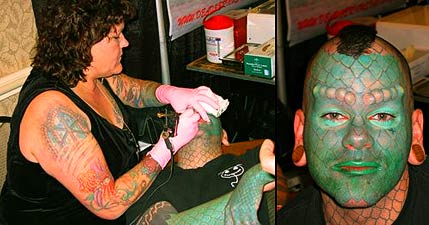 |
January |
|
Some things never seem to change (substantially). When I was writing the 2003 version of this column a year ago I had a small stack of books and pc games I was working through surrounding me.
As I sit here doing this one, I have a similar Christmas booty in front of me. January 2004 saw me off to a good start on the year. Shannon was kind enough to make my IAM page more open to the general public. I began a series of sideshow personality interviews beginning with my good friend The Amazing Blazing Tyler Fyre. I was filmed by MTV and National Geographic. I got one of now favorite and most beloved gadgets – the Treo 600. And perhaps most notably from a performance body modification perspective I once again worked at the AMJAM Tattoo Expo during which I had my lips tattooed. |
 |
February |
|
This was the month of the nipple piercing – thank you Miss Jackson! When I get to nipple on broadcast TV and a pierced nipple at that, I simply cannot contain myself. My feelings became expressed in a BME column, of course, and not surprisingly were far more enthusiastic than those of the popular press. February also saw this story on magnetic implants, a good month for modification. For my own mods I experimented with Kaos’s new silicone eyelets to stretch my septum. The results were positive except that after stretching with their eyelets I got my septum to a size where the only jewelry I could wear were the eyelets since non-squish-able jewelry over half an inch won’t fit up my nostril to be inserted into the piercing. Ultimately, I went back to a half inch for the jewelry options. Show wise, I made an appearance at Godsmack’s Grammy Party in LA, did a three day run in El Paso and Las Cruces (selling out and setting an attendance record for one of the rooms), and confirmed our spot on the Spring Jager Tour with Slipknot.
|
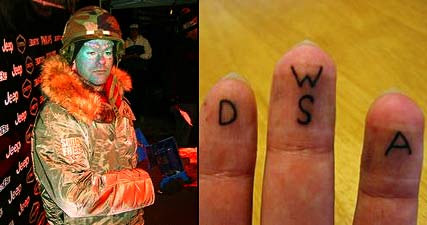 |
March |
|
I moved to Texas but I didn’t escape the cold. March saw me drawn back up north for a small show at the bar in Albany where I used to work (now under new management and ownership) and a trip to Stratton, VT for the US Snowboard Open as an award presenter for Sobe. I also made a trip out to San Francisco to appear on Unscrewed. Back home in Austin, my wife became one of the new Satan’s Cheerleaders.
At the end of the month I left for the Spring Jagermeister Music Tour but not before getting |
 |
April |
|
All of this month and half of May were spent on the road as the host of the Jagermeister Music Tour. This was one of the best tours I have ever had the honor of being part of and stands out as one of the great experiences of my life. |
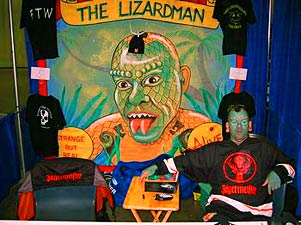 |
May |
|
After returning from tour I took easy for a couple weeks before heading up to Detroit for the Inkslinger’s Convention. More noteworthy for the month were the ocular modifications appearing on BME like the stories on eyelid piercing and eye implants.
|
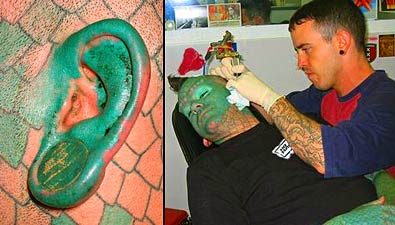 |
June |
|
Ronald Reagan died this month; my feelings about him are pretty well summed up in the Ramones’ song: Bonzo goes to Bitburg. It was good month for promotion. A number of TV shows I shot for were aired and I received the first shipment of Jagermeister sponsored gear: shot glasses & lighters. This was also the month that I celebrated my 32nd birthday and got my ears tattooed.
|
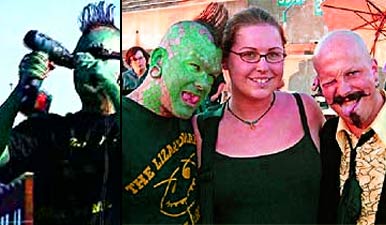 |
July |
|
Start of a month with BMEfest and its pretty much all downhill from there. That is, unless you are buying a house. This was the month that Meghan and I found and put in our offer on what would become our home.
|
 |
August |
|
Things got busy fast in August. Meghan and I closed on our new house, which meant moving. All the while I was spending 4 days or more a week in Dallas as a guest performer with the Brothers Grim Sideshow. I also went out to the Navajo Nation and performed at Window Rock fest. I believe I may have set a record this month, as well, when I pulled my car with my stretched earlobes for an audition tape – I didn’t get the part though, for being too extreme.
|
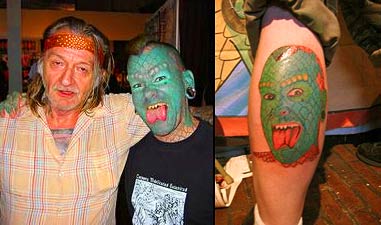 |
September |
|
I continued to split my time for the first half of the month between Dallas at the sideshow and home in Austin. While home there was moving, unpacking, and renovations to be done. In Dallas we not only performed but also filmed with Discovery – a series of vignettes for a number of programs that should air in 2005. I also got a little tattoo work done. A short trip north was made for the Boston Tattoo Convention during which MTV finally decided to air our wedding (without letting us know).
|
 |
October |
|
The month for me began with a new round of debating and interviewing over tongue splitting legislation. This time it was in New York. It behooves us all to stay abreast of what is being done legislatively – even in states other than our own. I got a little more green fill done this month but the mod I remember most, if you want to call it that, was a serious ear cleaning. I had a sudden wax buildup that nearly deafened me and needed to be removed by a doctor. With the Fall Jagermeister Tour not starting till the end of the month I only had one show to do (Theo’s in Corpus Christi) and passed the rest of the time mostly relaxing at home and learning to program
pocketc. |
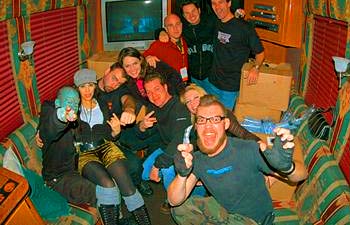 |
November |
|
Another national tour! We hit the road with Jagermeister once again. While on tour Meghan and I celebrated our one year wedding anniversary.
|
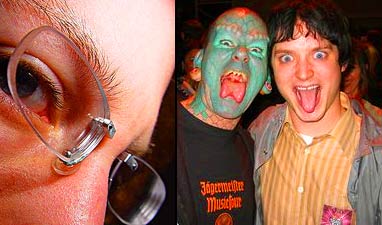 |
December |
|
I didn’t get back from the jager tour with Slayer till over half way through the month and then it was all holidays. While not much happened modification-wise for me personally, there was this story on BME about pierced eyeglasses and, of course, the ten year mark for BME.
|
There you have it. I promise some more substantive columns soon but for those looking for more year end nostalgia why not try here.

because the world NEEDS freaks…
Former doctoral candidate and philosophy degree holder Erik Sprague, the Lizardman (iam), is known around the world for his amazing transformation from man to lizard as well as his modern sideshow performance art. Need I say more?
Copyright © 2005 BMEzine.com LLC and Erik Sprague / The Lizardman. Requests to republish must be confirmed in writing. For bibliographical purposes this article was first published January 13th, 2005 by BMEzine.com LLC in La Paz, BCS, Mexico.
TransVision 2004 Coverage: Part One [The Publisher’s Ring]

TransVision 2004 Coverage PART ONE: A RAMBLING OVERVIEW OF TV2004
|
“Transhumanism is a way of thinking about the future that is based on the premise that the human species in its current form does not represent the end of our development but rather a comparatively early phase.”
– Prof. Nick Bostrom, Oxford University
|
Below are a few photos we took at TransVision. I felt a little bit like a “science groupie” asking people to let me take a photo with them, but hey, it was exciting for me! I should also note that in this article I’ve barely skimmed the surface of most of these brilliant minds — I strongly encourage you to check out their websites and google them for more.
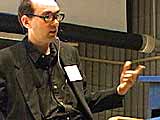
Steve Mann (wearcam.org) speaking about wearable computing, glogging, and sousveillance. I really urge you to visit his websites to learn more about how he’s augmenting and mediating the human experience using a cyborg body.
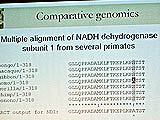
João Pedro de Magalhães of Harvard Medical School talking about his work in trying to find — and one day cure — the genetic causes of aging. You can see in this picture how unfortunately empty the event was.

![]()

![]()

Dr. Rafal Smigrodski (Gencia Corporation) talking about his work on mtDNA replacement which could cure diseases such as Parkinson’s, Alzheimers, and diabetes, as well as dramatically extending lifespans.

![]()

![]()

Biogerontologist Aubrey de Grey talking about life extension by “cleaning” our cells of the toxic aggregates that our bodies are currently unable to deal with. Great beard, great mind.
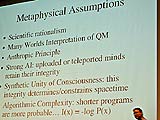
Allen Randall’s talk on “Quantum Miracles and Immortality” included discussion of a number of amusing thought experiments. In simple terms, quantum theory suggests that all possible states exist at once (ie. there are multiple worlds, like in that show Quantum Leap). Therefore, if you try to kill yourself in a way that has an (impossibly high) high chance of success in every one of these worlds, only the immortals survive — thus creating a quantum state that favors your immortality. I’m not really sure if this talk was supposed to be serious or just really funny, but I enjoyed it and I’ve always been a sucker for philosopher mathematicians.

Torsten Nahm from Bonn, Germany talking about aging, and arguing that being biological (wetware) sucks because of that aging. By moving into a digital form, we can become immortal, make backups of ourselves, experiment with different lives, and anything else we’d like. However, we need to decide whether the transition from one form of being to another involves not only rebirth, but death.
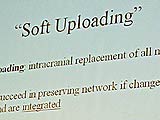
Ben Hyink’s talk on preserving network integrity during the process of uploading. That is, how do you keep an entity alive and conscious as it transitions into a new body? Unfortunately like many of the plenary talks, Ben was not able to fit all of his interesting ideas into the allotted time.

![]()

Anders Sandberg introducing Nick Bostrom’s closing talk. I first interviewed Anders for BME back in I think 1996. Anders’s enthusiastic online promotion of transhumanism has introduced thousands and thousands of people to a more forward-leaning way of thinking. I really liked Anders, although I only got to speak to him briefly. Super nice guy… actually, everyone I met at the event was really nice.

![]()

![]()

![]()

Nick Bostrom of Oxford University and the WTA puts transhumanism — and our need to embrace it — in simple and convincing terms in his closing talk. Nick is also the author of the transhumanism FAQ which is an excellent introduction to the subject along with Anders’s pages.
With George Dvorsky of Betterhumans, one of my hosts (Simon had already slipped out; I’d hoped to include both of them). As well as his work with Betterhumans, you may also want to check out his personal site and blog.

With Rudi Hoffman, “Cryonics Insurance Specialist”. I really got a kick out of Rudi — as much as he’s a real cliché of a salesman, he’s a a lot of fun and an incredibly enthusiastic spokesman for jumping into the future by jumping into a vat of liquid nitrogen. Contact Rudi if you’re trying to find an affordable way to have your brain — or entire body — frozen Futurama-style.

A group photo taken near the end of the event. Shannon Bell is on the far left (when I mentioned that Shannon had joined us to friends, they were extremely excited — she has a reputation for being one of the best professors you can have at York University, as well as being a distinguished author and researcher). In the middle of the front row is Stelarc who you’ll meet in more detail in part two of this article, and between them is José Luis Cordeiro who will be hosting TransVision 2004 in Caracas, Venezuela.
Transhumanism, at its simplest, is a way of thinking and being that embraces the idea that our experience as homo sapiens is just one small step in an ongoing evolution, and that we should take an active rather than passive role in “making ourselves better”. Transhumanists are a mix of philosophers, futurists, sci-fi buffs, and bona fide scientists advocating ideas such as uploading (the transfer of consciousness into computers), genetic enhancement, immortality, machine-human integration, and nanotechnology. Body modification culture lies on a related path and represents a real-world application of breaking the biological mold and transforming ourselves into something we perceive as “better” than what nature gave us.
TransVision, the yearly convention of the World Transhumanist Association, took place in Toronto, Canada for 2004 and BME was there thanks to an invitation from our friends over at BetterHumans. It took me a moment to actually figure out where it was being held, because nowhere on their website did it list an address or even the name of the building that was being used — but, after a bit of googling for the JRR McLeod Auditorium, we made our way to the University of Toronto Medical Sciences Building.
The conference had drawn speakers from all over the world — a sizable European and Scandinavian contingent, South Americans, and of course plenty of Canadians and Americans. It seemed to touch on every demographic from young fashionable cyberpunk kids, übergeeks, scientists, artists, and one seeming half-wit conspiracy nut that asked “how many methods of human improvement are there”, besides “chemical augmentation” (which he certainly seemed to be enjoying) at every talk he attended. One thing that surprised me was how empty the event was and how few people other than the speakers seemed to be there — many of the talks I would attend had less than twenty people sitting in the auditorium, with most of the seats empty.
After picking up our press passes, Phil Barbosa (who’d joined me to help film the event) and I went to the front row to wait for the opening talk by Steve Mann to begin. Steve Mann is the real deal. A genuine geek that looks every bit the part, Steve Mann has lived with wearable computing and camera technology since the mid 1970s and is a leading — and seed — researcher in these fields. He’s vehemently anti-corporation, is a political activist on surveillance issues, as well as being an environmentalist using guerrilla installations of solar cells and wind turbines.
Mann concentrated his talk on what he’s best known for: glogging, or “cyborg logging”, a form of literature (if that’s the right word) that predates but closely resembles blogging and moblogging and mandates that the glogger extend their body and consciousness into artificial and reconfigurable appendages. Using his wearable computing and media system, sometimes in collaboration with other cyborgs, he explores, documents, and shares his view of the world he sees. His inverse surveillance or sousveillance (“watching from below”) regularly brings him in conflict with those watching from above — he observes that those who run their own surveillance cameras are usually those most offended at his sousveillance of them in return. Mann went on to talk about “dusting”, a slightly improved version of an additive compositing technique that’s been in common use since the beginning of photography, which he seemed to think was important. This illustrated one of the pitfalls about becoming so engrossed in personalized technology while being heralded as the primogenitor — a difficulty in recognizing or taking seriously work done by other researchers.
As much as Steve Mann gave a largely brilliant talk, it also illustrated a fundamental problem in passing knowledge and ideas from hardcore geek culture to the mainstream: it’s not that charismatic (Reason magazine described Mann as “rather creepy” and spoke of him derisively in their event report). Steve displays a sense of humor that’s highly personal and a difficulty in communicating with other humans, which is genuinely ironic given the amazing tools he’s helped developed to facilitate these communications. His websites are ugly and primitive, the photos of him wearing his inventions are “unflattering” to say the least, and he uses common terms in ways that are awkward and unconventional (such as his insistence that Linux and other open source programs are not software, because wares are items of commerce — better tell that to the open source software movement). The best chefs understand that the way they present their dish greatly affects diners perception of it… Scientists need to embrace the reality of human interaction and start to include marketing as an important part of transhumanist dialog. Body modification for example is successful not just because it’s “right”, but also because it’s cool and accessible.
The title of Steve Mann’s talk had been “Glogging: Sousveillance, Cyborglogs, and the right to self-modification.” The right to self-modification is of course something that I’m very concerned about since it affects the readers of BME (and myself) on a daily basis, and is one of the key points where transhumanism and body modification intersect. Ultimately if we’re going to leap forward from these dirty ape fleshbag bodies of ours, we have to embrace the right of every individual to transform themselves in any way they see fit, be it a split tongue or be it a robotic tongue. Unfortunately, Mann hadn’t mentioned a word about it in the talk, which I found odd given that it was part of the title, so I asked him about it afterwards — given that in many parts of the Western world, even traditional “self-modification” like tattooing is illegal, was there any movement inside transhumanist circles to politically fight for the right to self-modification?
While Mann didn’t know of any such battle, he does have an interesting counter-attack to those who tell him he has to remove the electronic parts of his body — he says “sure, but only if you sign this form assuming liability if I’m injured due to not having them.” It’s a curious idea — if an augmented human is “more” than an unaugmented human, does that mean that in relative terms a normal human is handicapped? Is taking a cyborg’s electronics away the same as telling someone they can’t wear their glasses, or can’t ride on their electric wheelchair? Since we can always improve, where does one draw the line — and should one draw such a line at all? If we’re thinking along such paths, is not genetically improving your child a modern form of child abuse? Or will political correctness force us to define “human” as “stupid and limited, and that’s how we like it?”
Later in the conference I attended a talk by Dr. Rafal Smigrodski, a specialist in mitochondrial genome manipulation. In “how to buy new mitochondria for your old body” he describes what he believes could add a decade or more to people’s lifespans, as well as curing many mitochondrial disorders using a technique not so different from the Keith Richards urban legend in which he solves his heroin addiction by flying to Switzerland where all of his blood is removed and completely replaced with new, healthy, and unaddicted blood. Dr. Smigrodski touched on the right to self-modify issue as well, pointing out that he’s been forced to concentrate his research on those with diseases or otherwise improperly functioning physical forms — and that convincing governments that aging is a disease will be far from an easy thing, even though aging appears to be a terminal condition that we all suffer from. I think it was Nick Bostrom that would say later in his closing remarks that most people have a Stockholm Syndrome type relationship with aging, whereby they give artificial value to that which has imprisoned them.
From my point of view, the right to self-modify is something that transhumanist researchers should be embracing. It’s all well and good to develop technologies that ease the suffering from extremely rare disorders, and maybe that gives us “expendable” people to experiment on (it’s a terrible way to put it, but if we use the ill as fair game to do our early experiments on, that is what we’re doing), but until these technologies are available in unrestricted form to the general public, they’re not particularly transhumanist. Perhaps I’m speaking callously, but in my opinion, if we’re to move humanity forward, we should be concentrating on transforming the best of humanity into something even more, rather than trying to alleviate suffering in that tiny, tiny minority of people who are born with terminal or crippling diseases.
Aubrey de Grey as well gave a fascinating talk on “removing toxic aggregates that our cells can’t break down”, but he as well must face these same issues — how do you start using these technologies to enhance humans, rather than just fixing them when they break? I don’t want to keep repairing my old Ford Escort… I want an upgrade to a flying Lamborghini.
I’d come into the conference assuming that most transhumanists shared my own views: that we should be aggressively transforming humans into the things we dreamed of as children slumbering after spending the day reading science fiction, beings with far more power and options than we have as humans. However, there’s certainly no agreement inside transhumanism that this is the right goal. Mark Walker, editor of the Journal of Evolution and Technology and research fellow at Trinity College, spoke on the Genetic Virtue Program which he proposes is “the only hope on the horizon that humans might remove themselves from the slaughter bench of history.”
The basic idea is that since behavior is at least thirty to forty percent inherited (so you will act like your parents) and thus genetic in nature, that by using genetic manipulation we can, in time, breed a race of humans that are more compassionate and loving, and less aggressive, greedy, and prone to lying (and presumably sinning). While there is a certain truth to Walker’s proposals, the idea of using science to limit humans rather than expand them wasn’t really received that well by the audience. I pointed out that historically progress tends to be made by selfish, aggressive, and sometimes even “evil” people, and that breeding a society of well behaved losers might not be in our best interests as a species. One neurologist in the crowd pointed out that the ability to lie was an important part of an advanced mind, closely linked to the ability to consider different variations on the same idea, and that attempts to genetically force moral behavior might have to sacrifice intelligence in exchange — but Walker’s ideas certainly underscore the fact that there are a myriad of ways to move humanity forward (as well as many definitions of “forward”), and that transhumanism covers a very broad range of politics and faiths.
As is probably clear, I enjoy the hard science, and I believe that we must embrace the absolute right to use that science to better ourselves. To me, that’s the whole point — if all science does for us is fix people who are born “broken”, then we’re actually moving in the wrong direction. While I certainly hope that we can care for all people, if resources are going to be poured into improving humanity, I’d like to see it poured into improving the best humans, thereby moving us into the future. Because of this, I was looking forward to seeing Natasha Vita-More’s “posthuman prototypes debate their own design.”
When Natasha got on stage, more flash bulbs went off than at any other talk I’d been to. With zoom lenses fully erect, an army of transhumanist men showed they were still slaves to testosterone — Natasha lives in a transhumanist body herself with obviously “augmented” mammalian features and a clear attention to fitness and form. I don’t say this to be crass — the mass appeal of extreme cosmetic surgery is very relevant to transhumanist bodies and I was looking forward to hearing her thoughts on it. Unfortunately her talk was rubbish and full of sloppy thinking and inadequate research. She’d “interviewed” a number of fictional and non-fictional post humans, including her own imaginary creation “Primo”, Agent Smith from The Matrix, and Honda’s Asimo robot.
She “asked” these entities what they thought about themselves, humans, and so on, and in her answers made it clear that she had little comprehension of the technology involved, and was primarily interested in making her own sadly uninformed comments. Most obviously she claimed that Asimo was a primitive machine that could do no more than walk up and down stairs, a foolish statement to put it politely. Her commentary on the other technologies was equally ignorant, and her own “Primo” creation showed that she couldn’t even use the terminology correctly (ever get annoyed at the technobabble in Star Trek?) let alone illustrate it in a way that anyone can take that seriously — even if you’re just an “artist”, you still have the responsibility to understand the language you’re speaking. This saddened me, because Natasha is clearly a brilliant and creative women, but she disgraces herself when she speaks so foolishly.
Unfortunately Natasha was not the only person speaking this way at TransVision. I suppose that’s to be expected when you have a wide range of people commenting on such a diverse subject, but what disturbed me about it was that few inside transhumanism seem to have the courage to shout out “the emperor wears no clothes”, but instead seem to prefer a circle-jerk where everyone congratulates each other on how clever they are with little willingness to look at the thoughts critically — although they’ll galdly rip to shreds outsiders who criticize them.
In my opinion, transhumanism doesn’t need ill-informed people who go off on flights of “what if” fancy. You know what? All of us have been doing that since we were five years old. What transhumanism needs is transhumanists. Not people who talk about. People who do it. I have enormous respect for people like Steve Mann and Stelarc (or Todd Huffman with his magnetic vision) who are actually out there living transhuman lives and having transhumanist experiences, rather than just talking about them without any first-hand knowledge, as well as the scientists doing the foundation research that will make it possible. I am not convinced that the philosophers and artists are any different from science fiction authors — an important element in inspiring people to live as transhumanists, but no more than that.
As much as the conference was utterly unpromoted and almost unattended, there was an abundance of fascinating characters. Sitting next to me at several of the events was the boisterous and friendly Rudi Hoffman who was there selling life insurance for those seeking cryogenic suspension with Alcor — for about $40 a month you can buy an insurance policy ensuring that upon death you’ll be frozen a la Han Solo. Unfortunately the insurance doesn’t cover the cost of bringing you back to life — it’s hoped that future generations will do so for you. But still, your chances for reincarnation, as slim as they may be, are a lot better if you’re preserved in a vat of liquid nitrogen than if you’re rotting in a pine box buried in the ground.
Also sitting next to me — in the front row — for several of the talks was a tall, slender Asian man with a big bag of groceries. Oblivious to those around him, he prepared and ate several salads and fruit dishes, carefully weighing them and then entering them into a spreadsheet on his laptop as he ate, afterwards spending ten minutes loudly flossing his teeth. This seemed to me to be a strange thing to do, and by their strained glances at him, I think some of the speakers were debating whether or not they were being insulted. Later I discovered that he believed that in order to best achieve longevity one should adopt a paleolithic diet, since that’s what our bodies are presumably evolved to survive on.
Meeting José Luis Cordeiro, the host of TransVision 2005 (to be held in Caracas, Venezuela) was rewarding as well. Cordeiro has written extensively on both transhumanism and the socio-political future of Latin America, but even though his books sell well from Mexico southward, he’s had little luck reaching the North American market — as he opined in a seminar on writing transhumanist books (moderated by Simon Smith) information flows out of America, but rarely in. I believe that Cordeiro is exactly what transhumanism needs — an optimist (but a realist) with a technical background, and with a sense of humor and the charisma required to present far-out ideas to the general public.
All this said, I really must encourage readers to take advantage of events like TransVision when they happen in your area. Don’t underestimate the value of getting to meet world class thinkers — even the ones you disagree with — in person. Don’t underestimate the value of introducing yourself into dialogs you might otherwise not be able to have. As much as I didn’t think much of a few of the presenters, the ones I disagreed with the most are also the ones that got me thinking aggressively about where humanity is going and how we should take it there.
Finally, if I could say one thing to transhumanists in general, it is to follow Steve Mann and Stelarc’s example and make it real. Don’t just talk about far future fantasies. Taking the first step may not be as fantastical as masturbating over the year 3000, but it’s the only way that we can force transhuman evolution without being restricted by governments and corporations, who will act in the best interests of nationalism and capitalism, rather than humanity’s future. While it’s true that we’ll see the occasional Mr. Hyde as a result, I call out to Bruce Banner: it’s time to irradiate yourself.

Shannon Larratt
BME.com
